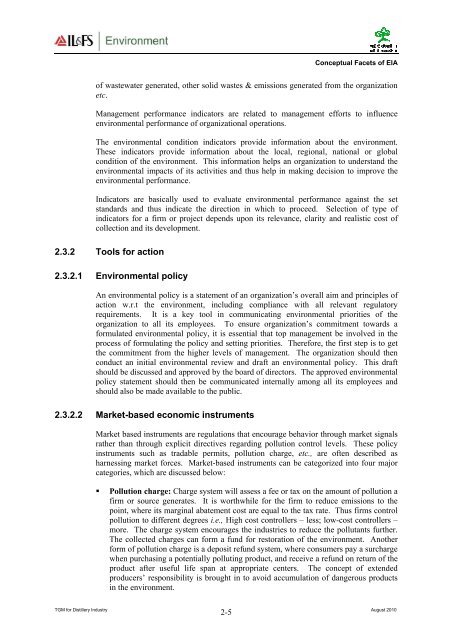Distillieries - Environmental Clearance
Distillieries - Environmental Clearance
Distillieries - Environmental Clearance
Create successful ePaper yourself
Turn your PDF publications into a flip-book with our unique Google optimized e-Paper software.
Conceptual Facets of EIAof wastewater generated, other solid wastes & emissions generated from the organizationetc.Management performance indicators are related to management efforts to influenceenvironmental performance of organizational operations.The environmental condition indicators provide information about the environment.These indicators provide information about the local, regional, national or globalcondition of the environment. This information helps an organization to understand theenvironmental impacts of its activities and thus help in making decision to improve theenvironmental performance.Indicators are basically used to evaluate environmental performance against the setstandards and thus indicate the direction in which to proceed. Selection of type ofindicators for a firm or project depends upon its relevance, clarity and realistic cost ofcollection and its development.2.3.2 Tools for action2.3.2.1 <strong>Environmental</strong> policyAn environmental policy is a statement of an organization’s overall aim and principles ofaction w.r.t the environment, including compliance with all relevant regulatoryrequirements. It is a key tool in communicating environmental priorities of theorganization to all its employees. To ensure organization’s commitment towards aformulated environmental policy, it is essential that top management be involved in theprocess of formulating the policy and setting priorities. Therefore, the first step is to getthe commitment from the higher levels of management. The organization should thenconduct an initial environmental review and draft an environmental policy. This draftshould be discussed and approved by the board of directors. The approved environmentalpolicy statement should then be communicated internally among all its employees andshould also be made available to the public.2.3.2.2 Market-based economic instrumentsMarket based instruments are regulations that encourage behavior through market signalsrather than through explicit directives regarding pollution control levels. These policyinstruments such as tradable permits, pollution charge, etc., are often described asharnessing market forces. Market-based instruments can be categorized into four majorcategories, which are discussed below:Pollution charge: Charge system will assess a fee or tax on the amount of pollution afirm or source generates. It is worthwhile for the firm to reduce emissions to thepoint, where its marginal abatement cost are equal to the tax rate. Thus firms controlpollution to different degrees i.e., High cost controllers – less; low-cost controllers –more. The charge system encourages the industries to reduce the pollutants further.The collected charges can form a fund for restoration of the environment. Anotherform of pollution charge is a deposit refund system, where consumers pay a surchargewhen purchasing a potentially polluting product, and receive a refund on return of theproduct after useful life span at appropriate centers. The concept of extendedproducers’ responsibility is brought in to avoid accumulation of dangerous productsin the environment.TGM for Distillery Industry August 20102-5

















